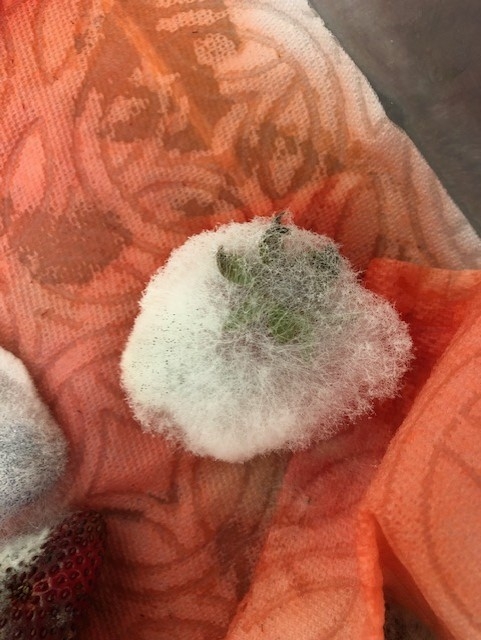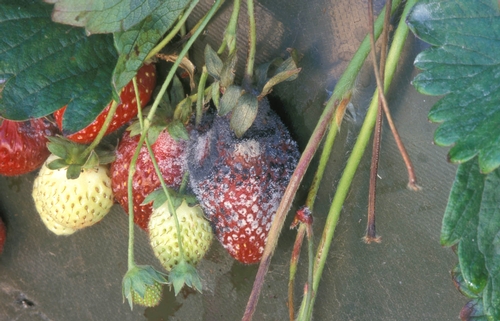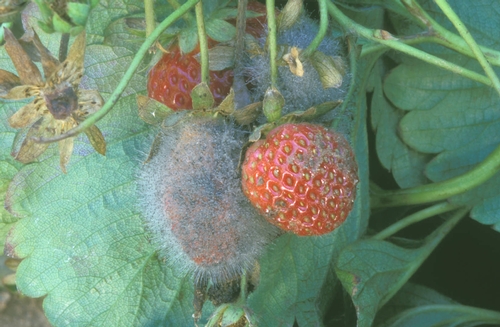Posts Tagged: Mucor
Exemplar Mucor Growth on Strawberry
I was holding some strawberry fruit a few weeks ago to check on a pathogen for a local grower (it's very likely anthracose, but more to come on that account), and of course this being late season had a lot of leak rot showing up.
Can't help myself here folks, but this one is a beauty! The undisturbed conditions of the moist chamber let the fungus really blow up and spread out. Again, as readers of this blog will know the sticky wet appearance of the sporangiophores tell us this is very likely to be Mucor rather than Rhizopus.
The leak rots are difficult to manage in the field, and in fact the only thing strawberry growers have available are cultural controls. The UC IPM guidelines instruct us that to minimize leak issues, handle fruit with care at all times. Remove all ripe fruit from the field at harvest and avoid packing overripe fruit. Be sure when fruit is being picked that the entire fruit is removed from the stem, not leaving behind the fleshy receptacle of the fruit as it can serve as a site for invasion by fungus.

Mucor rot on strawberry. Note the fluffy appearance and wet sticky aspect of the sporangiophores. The paper towel used to be white, but has been completely stained with juice leaking out of the fruit.
Rhizopus and Mucor fruit rots in strawberry.
Two pathogens that strawberry growers face all year long but especially now during the fall are Rhizopus and Mucor, which both cause a fruit rot that is distinctive and very different from the more common gray mold fruit rot caused by Botrytis cinerea.
The fruit rot symptoms caused by Rhizopus and Mucor look very similar. Fruit infected with either of these pathogens become very soft and start to leak sticky red juices from the fruit tissues. In later stages of infection fruit softens to the point that it is no longer solid and cannot be picked up without falling apart. Affected fruit are usually covered with the wispy, fuzzy black and white growth of the pathogen. Both Rhizopus and Mucor fungi are fairly easy to distinguish from Botrytis gray mold. The Botrytis fruit infection does not substantially soften the fruit, extensive leaking of fruit juices does not occur, and Botrytis growth on strawberry fruit will be gray to tan in color.
While the fruit softening symptoms of Rhizopus and Mucor are similar, the two fungi can be distinguished from one another by examining the fungal growth with a hand lens. Look for the tiny, dark brown to black, spherical structures on the ends of the white fungal strands. These black spheres are the spore bearing structures, or sporangia. For Rhizopus the sporangia appear dry while the Mucor sporangia are wet or sticky looking due to a viscous liquid film. In addition, examine the general orientation or arrangement of the sporangia within the fungal growth. For Mucor the sporangia are usually lined up in parallel rows or stands. Sporangia of Rhizopus, however, appear randomly and are not found in any particular order or arrangement.
There are several ways to minimize the infection of fruit by Mucor and Rhizopus. Use plastic mulch and drip tape, like most strawberry growers are already doing, since they minimize contact of the fruit with soil and water. Practice good field sanitation by getting rotten fruit away from plant. Handle fruit in a way to minimize wounding, which opens an avenue for these fruit rots. Cooling fruit quickly after harvest is helpful to minimize spread and development of Rhizopus, since this pathogen is not very active below 40oF; conversely Mucor is less affected by cold temperatures and could slowly develop in storage.
As for fungicides, Captan and Switch are already known to be effective. Our annual fungicide evaluation experiments include a post-harvest component and provided additional information on fungicide efficacy against Rhizopus/Mucor. Ripe fruit were harvested from each treatment replicate, placed in a dry, open air box at room temperature, and evaluated for disease for several days. We found Pristine to be consistently good at suppressing both fruit rots.
Before using any fungicide product, check with your local Agricultural Commissioner's Office and consult product labels for current status of product registration, restrictions, and use information.

Photo courtesy Steven Koike, UCCE. Rhizopus rot on strawberry. Note the mature, black sporangia.

Photo courtesty Steven Koike, UCCE. Mucor rot on strawberry. Note sporangia which appear to be lined up in parallel rows or stands of this fungus.

